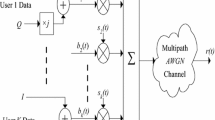Abstract
In recent years, a great deal of research has been performed on methods of alleviating the performance degradations suffered by code division multiple access (CDMA) systems due to multiple access interference. In this paper, we consider a multistage detector for noncoherent CDMA using M-ary orthogonal signals. Using a decorrelating detector as its first stage, the detector iteratively estimates the multiple access interference affecting the desired signal, subtracts the estimated interference, and forms symbol estimates for each of K users. Through numerical examples, the bit error performance of the proposed detector is demonstrated to be superior to that of previous detectors for the same signalling scheme.
Similar content being viewed by others
References
A. Duel-Hallen, J. Holtzman and Z. Zvonar, Multiuser detection for CDMA systems, IEEE Personal Communications (April 1995) 46– 58.
R. Gejji, Forward-link power control in CDMA cellular systems, IEEE Transactions on Vehicular Technology 41(4) (November 1992) 532.
C. Hegarty, Noncoherent multiuser detection, D.Sc. Dissertation, Department of Electrical Engineering and Computer Science, The George Washington University (1997).
C. Hegarty and B. Vojcic, Two-stage multiuser detection for noncoherent CDMA, in: Proceedings of the 33rd Annual Allerton Conference on Communication, Computer and Control, Allerton, IL (October 1995).
C. Hegarty and B. Vojcic, Noncoherent multiuser detection of M-ary orthogonal signals using a decorrelator, in: IEEE Military Communications Conference, Reston, VA (October 1996).
R. Kohno, R. Meidan and L. Milstein, Spread spectrum access method for wireless communications, IEEE Communications Magazine 23 (January 1995) 58–67.
E. Kudoh and T. Matsumoto, Effects of power control error on the system user capacity of DS/CDMA cellular mobile radios, IEICE Transactions on Communications 75(6) (June 1992) 524.
R. Lupas and S. Verdu, Linear multiuser detectors for sychronous code-division multiple access channels, IEEE Transactions on Information Theory 35 (January 1989) 123–136.
R. Lupas and S. Verdu, Near-far resistance of multiuser detectors in asynchronous channels, IEEE Transactions on Communications 38(3) (March 1990).
M. Mokhtar and S. Gupta, Power control considerations for DS/CDMA personal communication systems, IEEE Transactions on Vehicular Technology 41(4) (November 1992) 479.
S. Moshavi, Multi-User detection for DS-CDMA communications, IEEE Communications Magazine 34(10) (October 1996) 124–136.
P. Patel and J. Holtzman, Analysis of a simple successive interference cancellation scheme in a DS/CDMA system, IEEE Journal on Selected Areas in Communications 12(5) (June 1994) 796–807.
R. Pickholtz, L. Milstein and D. Schilling, Spread spectrum for mobile communications, IEEE Transactions on Vehicular Technology 40(2) (May 1991) 313–322.
J.G. Proakis, Digital Communications (McGraw-Hill, 2nd ed., 1989).
D. Schilling, L. Milstein, R. Pickholtz, F. Bruno, E. Kanterakis, M. Kullback, V. Erceg, W. Biederman, D. Fishman and D. Salerno, Broadband CDMA for personal communications systems, IEEE Communications Magazine (November 1991) 86–93.
D. Schilling, L. Milstein, R. Pickholtz, M. Kullback and F. Miller, Spread spectrum for commercial communications, IEEE Communications Magazine (April 1991) 66–79.
F. Simpson and J. Holtzman, Direct sequence CDMA power control, interleaving, and coding, IEEE Journal on Selected Areas in Communications 11(7) (September 1993) 1085.
O. Tonguz and M. Wang, Cellular CDMA networking impaired by Rayleigh fading: system performance with power control, IEEE Transactions on Vehicular Technology 43(3) (August 1994).
M. Varanasi, Noncoherent detection in asynchronous multiuser channels, IEEE Transactions on Information Theory 39(1) (January 1993) 157–176.
M. Varanasi and B. Aazhang, Multistage detection in asynchronous code-division multiple-access communications, IEEE Transactions on Communications 38(4) (April 1990) 509–519.
M. Varanasi and B. Aazhang, Near-optimum detection in synchronous code-division multiple-access systems, IEEE Transactions on Communications 39(5) (May 1991) 725–736.
M.K. Varanasi and B. Aazhang, Optimally near-far resistant multiuser detection in differentially coherent synchronous channels, IEEE Transactions on Information Theory 37(4) (July 1991) 1006–1018.
S. Verdú, Minimum probability of error for asynchronous Gaussian multiple-access channels, IEEE Transactions on Information Theory 32(1) (January 1986) 85–96.
B. Vojcic, R. Pickholtz and L. Milstein, Performance of DS-CDMA with imperfect power control operating over low earth orbiting satellite link, IEEE Journal on Selected Areas in Communications 12(4) (May 1994) 560.
Author information
Authors and Affiliations
Rights and permissions
About this article
Cite this article
Hegarty, C.J., Vojcic, B.R. Noncoherent multistage multiuser detection of M-ary orthogonal signals. Wireless Networks 4, 319–324 (1998). https://doi.org/10.1023/A:1019168726229
Issue Date:
DOI: https://doi.org/10.1023/A:1019168726229




